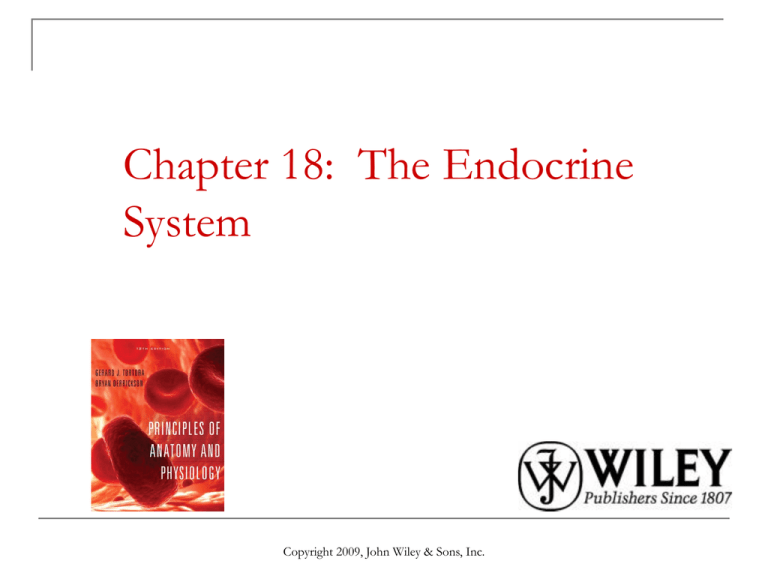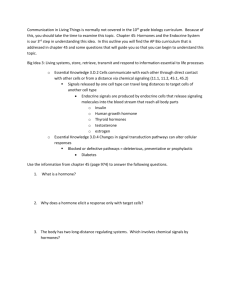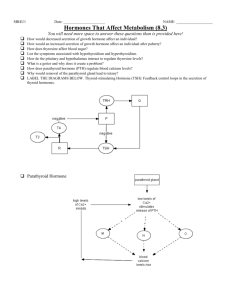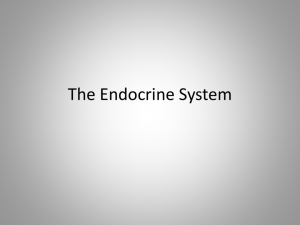s10.physio2.drlo2e
advertisement

Chapter 18: The Endocrine System Copyright 2009, John Wiley & Sons, Inc. Nervous and Endocrine Systems Act together to coordinate functions of all body systems Nervous system Nerve impulses/ Neurotransmitters Faster responses, briefer effects, acts on specific target Endocrine system Hormone – mediator molecule released in a part of the body to regulates activity of cells in other parts Slower responses, effects last longer, broader influence Copyright 2009, John Wiley & Sons, Inc. Nervous and Endocrine Systems Copyright 2009, John Wiley & Sons, Inc. Body Glands 2 kinds of glands Exocrine – ducted Endocrine – ductless Secrete products into interstitial fluid, diffuse into blood Endocrine glands include Sweat, mucous, and digestive glands. Pituitary, thyroid, parathyroid, adrenal and pineal glands Organs not exclusively endocrine glands Hypothalamus, thymus, pancreas, ovaries, testes, kidneys, stomach, liver, small intestine, skin, heart, adipose tissue, and placenta. Copyright 2009, John Wiley & Sons, Inc. Hormone Activity Hormones work through receptors Hormones affect only specific target tissues with specific receptors Receptors constantly synthesized and broken-down Copyright 2009, John Wiley & Sons, Inc. Hormone Activity Hormones work through receptors Hormones affect only specific target tissues with specific receptors Receptors constantly synthesized and broken-down Down-regulation & Up-regulation Copyright 2009, John Wiley & Sons, Inc. Hormone Activity Hormones work through receptors Hormones affect only specific target tissues with specific receptors Receptors constantly synthesized and broken-down They operate within feedback systems to maintain an optimal internal environment They are excreted by the kidney, deactivated by the liver or by other mechanisms Copyright 2009, John Wiley & Sons, Inc. Hormone types Circulating : circulate in blood throughout body Local hormones : act locally Paracrine – act on neighboring cells Autocrine – act on the same cell that secreted them Copyright 2009, John Wiley & Sons, Inc. Chemical classes of hormones Lipid-soluble – use transport proteins Steroid Thyroid Nitric oxide (NO) Water-soluble – circulate in “free” form Amine Peptide/ protein Eicosanoid Copyright 2009, John Wiley & Sons, Inc. Lipid-soluble Hormones • Steroids – lipids derived from cholesterol on SER – different functional groups attached to core of structure provide uniqueness • Thyroid hormones – tyrosine ring plus attached iodines are lipid-soluble • Nitric oxide is gas 18-12 Water-soluble Hormones • Amine, peptide and protein hormones – modified amino acids or amino acids put together – serotonin, melatonin, histamine, epinephrine – some glycoproteins • Eicosanoids – derived from arachidonic acid (fatty acid) – prostaglandins or 18-13 leukotrienes Hormone Transport in Blood • Protein hormones circulate in free form in blood • Steroid (lipid) & thyroid hormones must attach to transport proteins synthesized by liver – improve transport by making them water-soluble – slow loss of hormone by filtration within kidney – create reserve of hormone • only .1 to 10% of hormone is not bound to transport protein = free fraction 18-14 18-15 Mechanisms of Hormone Action Response depends on both hormone and target cell Water-soluble hormones bind to receptors on the plasma membrane Activates second messenger system Amplification of original small signal Lipid-soluble hormones bind to receptors inside target cells Responsiveness of target cell depends on Hormone’s concentration Abundance of target cell receptors Influence exerted by other hormones Permissive, synergistic and antagonistic effects Copyright 2009, John Wiley & Sons, Inc. Blood capillary 1 Binding of hormone (first messenger) to its receptor activates G protein, which activates adenylate cyclase Water-soluble hormone Adenylate cyclase Receptor Second messenger G protein ATP cAMP 2 Activated adenylate cyclase converts ATP to cAMP Protein kinases 6 Phosphodiesterase inactivates cAMP 3 cAMP serves as a second messenger to activate protein kinases Activated protein kinases 4 Activated protein Protein kinases phosphorylate cellular proteins ATP ADP Protein— P 5 Millions of phosphorylated proteins cause reactions that produce physiological responses Target cell Amplification of Hormone Effects • Single molecule of hormone binds to receptor • Activates 100 G-proteins • Each activates an adenylate cyclase molecule which then produces 1000 cAMP • Each cAMP activates a protein kinase, which may act upon 1000’s of substrate molecules • One molecule of epinephrine may result in breakdown of millions of glycogen molecules into glucose molecules 18-18 Mechanisms of Hormone Action Response depends on both hormone and target cell Water-soluble hormones bind to receptors on the plasma membrane Activates second messenger system Amplification of original small signal Lipid-soluble hormones bind to receptors inside target cells Responsiveness of target cell depends on Hormone’s concentration Abundance of target cell receptors Influence exerted by other hormones Permissive, synergistic and antagonistic effects Copyright 2009, John Wiley & Sons, Inc. Free hormone Blood capillary 1 Lipid-soluble Transport protein hormone diffuses into cell 2 Activated Nucleus Receptor receptor-hormone complex alters gene expression DNA Cytosol mRNA 3 Newly formed mRNA directs synthesis of specific proteins on ribosomes Ribosome New protein 4 New proteins alter cell's activity Target cell General Mechanisms of Hormone Action Hormone binds to cell surface or receptor inside target cell Cell may then synthesize new molecules change permeability of membrane alter rates of reactions Each target cell responds to hormone differently liver cells---insulin stimulates glycogen synthesis adipose---insulin stimulates triglyceride synthesis Mechanisms of Hormone Action Response depends on both hormone and target cell Lipid-soluble hormones bind to receptors inside target cells Water-soluble hormones bind to receptors on the plasma membrane Activates second messenger system Amplification of original small signal Responsiveness of target cell depends on Hormone’s concentration Abundance of target cell receptors Influence exerted by other hormones Permissive, synergistic and antagonistic effects Copyright 2009, John Wiley & Sons, Inc. Hormonal Interactions Permissive effect Synergistic effect a second hormone, is needed and strengthens the effects of the first thyroid strengthens epinephrine’s effect upon lipolysis Two hormones work together to produce a particular result. May be complimentary or as a greater effect estrogen & LH are both needed for oocyte production Antagonistic effects two hormones with opposite effects insulin promotes glycogen formation & glucagon stimulates glycogen breakdown Control of Hormone Secretion Regulated by Signals from nervous system Chemical changes in the blood Other hormones Chronotropic Most hormonal regulation by negative feedback (Few examples of positive feedback) Irregular control will lead to Disorders Copyright 2009, John Wiley & Sons, Inc. Types of endocrine disorders 1. Hypo-secretion Primary hypo-secretion Secondary hypo-secretion 2. 3. Deficiency in tropic “regulatory” hormone Hyper-secretion Hypo-responsiveness 4. Deficiency in resources for hormone production Malfunction in hormone producing organ Abnormal or deficiency in receptors Lack of activation enzyme Hyper-responsiveness Hormonal upregulation of receptor population (Example) Thyroid hormone to epinephrine receptor









